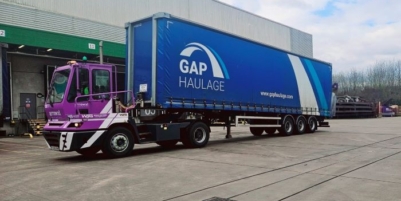-
Nutrivend selects Forterro’s Orderwise to support online expansion and streamline operations - April 11, 2025
-
ARROWXL LAUNCHES AMBITIOUS ZERO WASTE ROADMAP - April 8, 2025
-
THE BCMPA’S NEW CAMPAIGN DRIVES OUTSOURCING SUCCESS IN Q1 - April 7, 2025
-
BLACKOUT TECHNOLOGIES TARGETS TELEMATICS-INTEGRATED MOBILE DEVICE BLOCKING TO COMBAT SMARTPHONE DISTRACTION - April 1, 2025
-
Sparck Technologies awarded Royal designation - March 27, 2025
-
OpenADR Alliance announces first OpenADR 3.0 certified products with EVoke Systems, E.ON Energy and Universal Devices - March 25, 2025
-
Growing fulfilment and contract packer appoints new Managing Director - March 25, 2025
-
When is it time to invest in a WMS? Understanding the key trigger points - March 25, 2025
-
eCapital helps Vantage Recruitment on its journey to financial success - March 24, 2025
-
Hugo Beck Celebrates 70 Years of Packaging Innovation with Open House Events - March 20, 2025
The COVID-19 pandemic served as a wake-up call, forcing companies to realise the risk of not knowing who their suppliers’ suppliers are.
Despite facing numerous upheavals inflicted by supply chain disruptions in the last decade, most companies still found themselves alarmingly unprepared for COVID-19. When the outbreak began in China, the disruptions were significant and far reaching but 70% of organisations did not have a clear sense of what parts of their supplier network were affected. Instead, they were still in a “data collection and assessment” mode, manually trying to identify which of their suppliers had a site in the specific locked-down regions of China. The effort was exponentially complicated as countries around the world went into various stages of lockdowns and restrictions and supply chain experts spent several months reacting and responding.
In contrast, companies that invested in supply chain risk management tools, particularly mapping their supplier networks, had a different experience. They were able to conduct what-if analyses for different regions as the first few cases emerged and were able to work with suppliers in these regions preemptively to protect supply lines.
As the pandemic ramped up, companies that had mapped their supply networks down to the second-and third-tier levels could quickly see a complete picture of how the evolving crisis would affect their supply chains in the weeks or months to come. This identification of specific areas of failure helped companies take action before the disruption hit. COVID-19 highlighted that mapping is essential for building resilient supply chains for the future.
Why doesn’t every company map its supply chain?
The simple answer is money and time. While historically it’s been costly for companies to develop and maintain an accurate map of their supply chain, today, with the right partners, the process can be much more streamlined and efficient. Rapidly evolving technology, AI, cloud adoption, and enterprise networks have made mapping cost effective, scalable, and achievable. What’s more, the new generation of software companies providing mapping capabilities go far beyond what could be accomplished with emails, phone calls, and spreadsheets.
There are a few types of mapping available; all provide different levels of value depending on a company’s needs. The simplest method involves mapping based on publicly available data including news and other information disclosed by large, direct suppliers about their production and logistics sites.While this method has the advantage of not requiring any input from suppliers, it also doesn’t allow for much transparency beyond the first supplier tier and may generate irrelevant data—noise—that must be filtered out to find the actionable data. This is because larger suppliers operate across many countries and not all sites may be relevant to a specific manufacturer.
To cut through the noise and increase visibility, companies should engage with suppliers to provide increasing levels of data. This data map can be achieved by starting with the locations of the suppliers’ own production and logistics sites and culminating with a comprehensive map detailing the linkages between tier-one, tier-two, and tier-three suppliers. The goal is to be able to trace individual parts to the exact site where they’re manufactured.
The benefits of part-site mapping
This ultimate level of “part-site” mapping adds the most value because it enables manufacturers and companies to know exactly what parts or materials may be delayed by an event affecting a specific site. The map should also include information about which activities a primary site performs, the alternate sites the supplier has that could perform the same activity, and how long it would take the supplier to begin shipping from the alternate site. This is the most effective method to ensure continuity of supply as well as minimising revenue and/or inventory loss.
For example, a biotech company leveraged part-site mapping to avoid supply disruptions after Hurricane Maria devastated Puerto Rico in September 2017. Before Maria made landfall, the firm was able to identify two Puerto Rican sites that supplied 25 to 30 items to its North American manufacturing operations. Assuming these sites would be compromised , the company made several million dollars’ worth of forward purchases from alternative suppliers that averted what would have been costly delays in manufacturing.
Identifying high risk parts and materials
Whatever technology platform a company uses to map its supply chain, a core best practice is to prioritise mapping those parts and materials that impact high-revenue products. Take this example: a company with £5 billion in revenue discovers that it has a single second-tier supplier for a low-cost connector that goes into its highest-revenue products. Without a mapping system that prioritises revenue, the company would probably not pay much attention to that vendor because of the relatively low annual spend associated with it. But in reality, this single-source vulnerability could derail production of a product that brings in hundreds of millions of pounds annually. In this case, it pays to spend several hundred thousand pounds to qualify an additional supplier.
Therefore, a change of mindset is what is needed: from focusing the most attention on suppliers with the largest spend, to focusing on those supplying products with the greatest potential to cut into a company’s topline instead. As procurement teams typically pay attention to the top 20% of suppliers which make up 80% of the spend, a significant risk remains within this strategy as you have zero visibility over 80% of your suppliers. Irrespective of spend, every part and raw material is required to produce and ship a given product, so significantly more attention should be directed towards lower tier suppliers which are usually where most disruptions occur. Companies need to map multiple tiers of suppliers in order to gain a greater understanding of potential revenue risk when disruptions occur.
The road to a resilient supply chain
Even amidst a pandemic, the usual types of disruptions continue. Everything from factory fires, weather-related disruptions, to geopolitical risks- no site or region will ever be risk-free. This is why mapping is so important. Whether contending with a labour shortage at one essential producer of high-performance raw materials or a pandemic that affects most of the world, supply chain mapping provides a foundational knowledge base and core asset that can be leveraged to build strong programs such as quality, compliance, sustainability, and supplier corporate social responsibility, to name just a few. This data allows companies to identify and anticipate vulnerabilities in their supply chain. It unlocks predictive analytics capabilities and enables them to act proactively. It allows them to respond to disruptions faster and more economically. It allows them to go from reactive to resilient. The journey to a diversified, supply chain risk management strategy begins with mapping.
About the Author
Bindiya Vakil is the CEO and founder of Resilinc and is an award-winning expert in supply chain risk management. For more information visit https://www.resilinc.com
































